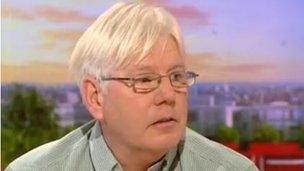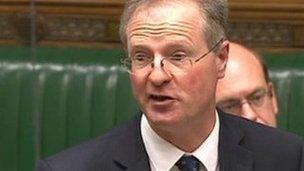Stafford hospital: Would new nurse number rules have prevented crisis?
- Published
Hospitals are to be made to publish the number of nurses they have on each ward, month by month.
From April, patients will be be able to access a website which shows how many staff are working and whether the numbers meet the recommended levels.
The move is part of the government's response to a public inquiry into failings at Mid Staffordshire Trust, after it was found poor care may have led to a higher-than-expected number of deaths at Stafford Hospital.
But if the trust had been forced to publish its nurse numbers, would it have stopped the problems?
Helene Donnelly, Whistleblower

Helene Donnelly gave evidence to the public inquiry into failings at the Mid Staffordshire Trust
Ms Donnelly, now ambassador for cultural change at Staffordshire & Stoke on Trent Partnership NHS Trust, raised nearly 100 complaints over the treatment of patients when she worked at Stafford Hospital between 2006 and 2009.
I think it would not have made a huge difference because we knew patients and staff, me included, raised concerns and were not being listened to.
Staffing levels are crucial because even the best nurse cannot deliver the best care they can if resources are limited.
Having the figures published to a website so everyone can see them is a good step forward because it can be picked up on if staffing is falling short and having an effect on patient care.
It is crucial action is then taken by the General Medical Council (GMC) or the Care Quality Commission (CQC) so problems can be addressed.
The new guidelines are solely dependent on cultural change and unless there is evidence of this those guidelines are meaningless.
Frank Robinson, Father

Frank Robinson has successfully campaigning to get a fresh inquest into his son's death
Mr Robinson's son, John Moore- Robinson, 20, died from a ruptured spleen in 2006 after being misdiagnosed at Stafford Hospital.
It could have helped. On the day John died there were no consultants on duty and he was examined by a very junior doctor with very little experience of A&E medicine.
It is a good move but as we know under this present government there's got to be a massive, massive U-turn and recruitment drive to bring staffing levels back.
If that happens that has to be a major plus, but I feel that the new policies do not go far enough to prevent other people going through what we did.
I am disappointed the full legal duty of candour has not been implemented.
If it had been in place before my son's case it would have saved us a lot of anguish and grief because we were kept in the dark about what happened to John for three years.
Jeremy Lefroy, Labour MP for Stafford

Jeremy Lefroy said he welcomed the government's response to the public inquiry's findings
The shortage of nurses was an element in the Stafford Hospital scandal and there's no doubt the lack of staffing put nurses under undue pressure, but this was mainly about the culture at the hospital.
There was top-down culture from the the senior management, who were cutting staff to save money and telling nurses "you've got to do this no matter the changes we make."
Secondly, there was a lack of compassion and concern for patients from some of the nurses who were there.
We will see if these recommendations address those issues. It's a very substantial response, but ultimately it will be down to those who run the NHS to implement them and people on the ground to carry them out.
It is about that nurse saying, "I'm going to give that patient the best care I can" even if they feel tired and overworked, which is a personal choice to make.
Paul Vaughan, West Midlands director of the Royal College of Nursing.

Paul Vaughan said the RCN had "long campaigned" for the publication of nurse staffing levels
In a word, yes.
It was one of the findings of the Francis report that staff shortages were a major part of the problem and put those nurses working on wards in a very difficult position.
It is good to see this response from the government because this is what the RCN have been saying for many years. You need to have the right staff numbers so quality of care is delivered right.
Since 2010 the number of qualified nurses has fallen from 38,221 to 37,861.
We know there are more hidden cuts in things like holding posts where the post exists but there is nobody in that job.
It is a big step forward that those staffing figures are now in the public domain for all to see.
- Published19 November 2013
- Published19 November 2013
- Published19 November 2013
- Published18 September 2013